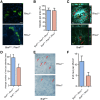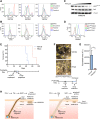The RhoJ-BAD signaling network: An Achilles' heel for BRAF mutant melanomas
- PMID: 28753606
- PMCID: PMC5549996
- DOI: 10.1371/journal.pgen.1006913
The RhoJ-BAD signaling network: An Achilles' heel for BRAF mutant melanomas
Abstract
Genes and pathways that allow cells to cope with oncogene-induced stress represent selective cancer therapeutic targets that remain largely undiscovered. In this study, we identify a RhoJ signaling pathway that is a selective therapeutic target for BRAF mutant cells. RhoJ deletion in BRAF mutant melanocytes modulates the expression of the pro-apoptotic protein BAD as well as genes involved in cellular metabolism, impairing nevus formation, cellular transformation, and metastasis. Short-term treatment of nascent melanoma tumors with PAK inhibitors that block RhoJ signaling halts the growth of BRAF mutant melanoma tumors in vivo and induces apoptosis in melanoma cells in vitro via a BAD-dependent mechanism. As up to 50% of BRAF mutant human melanomas express high levels of RhoJ, these studies nominate the RhoJ-BAD signaling network as a therapeutic vulnerability for fledgling BRAF mutant human tumors.
Conflict of interest statement
The authors have declared that no competing interests exist.
Figures





Similar articles
-
CDKN2B Loss Promotes Progression from Benign Melanocytic Nevus to Melanoma.Cancer Discov. 2015 Oct;5(10):1072-85. doi: 10.1158/2159-8290.CD-15-0196. Epub 2015 Jul 16. Cancer Discov. 2015. PMID: 26183406 Free PMC article.
-
Melanocytic nevus-like hyperplasia and melanoma in transgenic BRAFV600E mice.Oncogene. 2009 Jun 11;28(23):2289-98. doi: 10.1038/onc.2009.95. Epub 2009 Apr 27. Oncogene. 2009. PMID: 19398955 Free PMC article.
-
A Bifunctional MAPK/PI3K Antagonist for Inhibition of Tumor Growth and Metastasis.Mol Cancer Ther. 2017 Nov;16(11):2340-2350. doi: 10.1158/1535-7163.MCT-17-0207. Epub 2017 Aug 3. Mol Cancer Ther. 2017. PMID: 28775144 Free PMC article.
-
BCL2A1 is a lineage-specific antiapoptotic melanoma oncogene that confers resistance to BRAF inhibition.Proc Natl Acad Sci U S A. 2013 Mar 12;110(11):4321-6. doi: 10.1073/pnas.1205575110. Epub 2013 Feb 27. Proc Natl Acad Sci U S A. 2013. PMID: 23447565 Free PMC article.
-
RhoJ: an emerging biomarker and target in cancer research and treatment.Cancer Gene Ther. 2024 Oct;31(10):1454-1464. doi: 10.1038/s41417-024-00792-6. Epub 2024 Jun 10. Cancer Gene Ther. 2024. PMID: 38858534 Review.
Cited by
-
PAK1 and Therapy Resistance in Melanoma.Cells. 2023 Sep 28;12(19):2373. doi: 10.3390/cells12192373. Cells. 2023. PMID: 37830586 Free PMC article. Review.
-
Interleukin enhancer-binding factor 2 promotes cell proliferation and DNA damage response in metastatic melanoma.Clin Transl Med. 2021 Oct;11(10):e608. doi: 10.1002/ctm2.608. Clin Transl Med. 2021. PMID: 34709752 Free PMC article.
-
Rho GTPases in Retinal Vascular Diseases.Int J Mol Sci. 2021 Apr 1;22(7):3684. doi: 10.3390/ijms22073684. Int J Mol Sci. 2021. PMID: 33916163 Free PMC article. Review.
-
Structure-based design of CDC42 effector interaction inhibitors for the treatment of cancer.Cell Rep. 2022 Apr 5;39(1):110641. doi: 10.1016/j.celrep.2022.110641. Cell Rep. 2022. PMID: 35385746 Free PMC article.
-
Melanoma-associated mutants within the serine-rich domain of PAK5 direct kinase activity to mitogenic pathways.Oncotarget. 2018 May 22;9(39):25386-25401. doi: 10.18632/oncotarget.25356. eCollection 2018 May 22. Oncotarget. 2018. PMID: 29875996 Free PMC article.
References
-
- Campisi J. Suppressing cancer: the importance of being senescent. Science. 2005;309(5736):886–7. Epub 2005/08/06. doi: 10.1126/science.1116801 . - DOI - PubMed
-
- Michaloglou C, Vredeveld LC, Soengas MS, Denoyelle C, Kuilman T, van der Horst CM, et al. BRAFE600-associated senescence-like cell cycle arrest of human naevi. Nature. 2005;436(7051):720–4. Epub 2005/08/05. doi: 10.1038/nature03890 . - DOI - PubMed
-
- Lowe SW, Cepero E, Evan G. Intrinsic tumour suppression. Nature. 2004;432(7015):307–15. Epub 2004/11/19. doi: 10.1038/nature03098 . - DOI - PubMed
-
- Bild AH, Yao G, Chang JT, Wang Q, Potti A, Chasse D, et al. Oncogenic pathway signatures in human cancers as a guide to targeted therapies. Nature. 2006;439(7074):353–7. Epub 2005/11/08. doi: 10.1038/nature04296 . - DOI - PubMed
-
- Chapman PB, Hauschild A, Robert C, Haanen JB, Ascierto P, Larkin J, et al. Improved survival with vemurafenib in melanoma with BRAF V600E mutation. N Engl J Med. 2011;364(26):2507–16. Epub 2011/06/07. doi: 10.1056/NEJMoa1103782 . - DOI - PMC - PubMed
MeSH terms
Substances
Grants and funding
LinkOut - more resources
Full Text Sources
Other Literature Sources
Medical
Molecular Biology Databases
Research Materials

